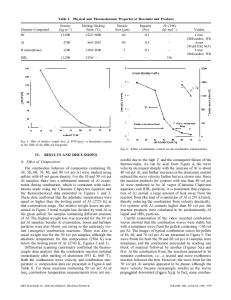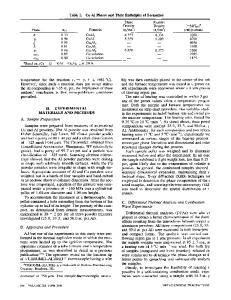Combustion Synthesis of Fullerenes
- PDF / 323,366 Bytes
- 6 Pages / 414.72 x 648 pts Page_size
- 92 Downloads / 389 Views
ABSTRACT The formation of fullerenes by combustion was investigated for nine benzene/ oxygen/argon flames, one acetylene/oxygen/argon- and one toluene/oxygen/argon flame burning at 75 mbar. The flame-generated soot was Soxhlet extracted with toluene and the extract analyzed by HPLC. It was shown that the C 6 dC 70 ratio depends on the percentage of argon in the fresh gas mixture, which is directly related to the flame temperature. The use of acetylene and toluene as combustible led also to the formation of fullerenes, the yield in the toluene flame being 3.71% of the generated soot, so that toluene represents a serious alternative to benzene for fullerene fabrication in flames.
INTRODUCTION Since the discovery of fullerenes by Kroto and Smalley', and their first macroscopic
production by means of the electric arc method (Kratschmer-Huffman) 2
3
, the investigation of
their physical and chemical properties has been rapid. These studies have shown potential application fields in material sciences, e. g. as superconductor4 , optical devices, batteries or catalysts5 , or in organic 6 and pharmaceutical 7 chemistry. Besides the archetypes " Ch0 and C70 the existence of larger fullerenes such as C78, C84 up to C300 has also been shown8' . An eventual industrial use of fullerenes will require production on a larger scale. Owing to the problems of up-scaling" the existing fabrication methods, i. e. electric arc (KrdtschmerHuffman) 2. 3 or carbon vaporization by pulsed lasers' 2 ' 13, fullerene production in sooting hydrocarbon flames is likely to become the preferred method for industrial production. In this work we describe the fullerene formation in low pressure flames using either acetylene, benzene, or toluene as combustible.
FULLERENE FORMATION IN SOOTING HYDROCARBON FLAMES The formation of fullerenes in flames was shown relatively early through investigations of the soot formation mechanism in hydrocarbon flames. In fact the first evidence of fullerene ions in acetylene/oxygen/argon- and benzene/oxygen/argon flames was presented in 1987 by the Homann group in Darmstadt 14. The first extraction of macroscopic amounts of fullerenes 17
Mat. Res. Soc. Symp. Proc. Vol. 359 01995 Materials Research Society
from flame-generated soot was achieved in 1991 by the Howard group at MIT15 16, 17. Further investigations suggested corannulene (C20 Hl0 ) as a fullerene precursor 8. In order to explain the chemical formation mechanism the Homann group discussed the role of polycyclic aromatic hydrocarbons (PAH) and of growing soot particles 19. Recently they suggested a precursor/product relation between C60Hx and C60 as well as between C7oHx and C70 with 1 < x < 4 in naphthalene/oxygen/argon flames 20 . A complex chemical mechanism for fullerene 21,22 formation in benzene/oxygen flames has been suggested by the Howard group
EXPERIMENTAL AND RESULTS Our experimental set-up uses a stainless steel combustion chamber in order to burn flat low pressure flames. It has been described elsewhere 23 . The fullerene formation in benze
Data Loading...











